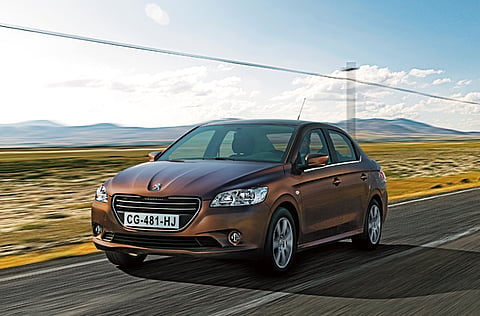Peugeot 301 driven in Turkey
Sony Thomas jets off to Turkey to drive a new Peugeot 301

With its bustling bazaars, teeming streets and trendy hangouts, Antalya, the incredibly beautiful tourist hotspot on Turkey’s Mediterranean coast, is a city bursting with life and colour. Seeing the buzz and generally upbeat mood around, it’s hard to imagine you’re in a country that’s part of a financially battered and bruised continent, let alone an ‘emerging’ part of it. No wonder then that it’s emerging markets like Turkey that major carmakers are going all out to woo with tailor-made offerings.
Just as Toyota and Honda enticed India with the Etios and the Brio, and GM and Hyundai courted Brazil with the Chevy Onix and the HB20 respectively, French majors are also striving to catch the fancy of the cash-rich middle class in these up-and-coming markets with made-to-measure models. With the Citroen C-Elysee and the Renault Symbol having already set the pace, Peugeot couldn’t be far behind, and it’s promptly come out with its symbol of “internationalisation” — the 301 saloon.
Long gone are the times when even the ugliest three-box sheet metal on wheels could be dumped on the Third World, which would happily gobble it up without as much as a raised eyebrow. The developing world is now demanding enough for these carmakers to spend considerable amounts of resources and time on making these cars look appealing. The 301 is a perfect example.
The 301’s styling draws heavily from the SR1 Concept shown at the 2010 Geneva show, and carries forward the new design language debuted with the larger 508 saloon. The front end features a chrome-outlined wide-mouth ‘floating grille’, with a smaller lower grille beneath it flanked by fog lamps. Although the car looks fairly plain and simple overall, the creases on the bonnet and along the beltline give it a sharper, more muscular appearance than what’s expected in this segment.
The biggest surprise is the interior, which is so well designed and put together that it looks like it belongs in a much pricier car. Everything from the buttons and knobs on the driver-oriented dashboard to the flat-bottom steering wheel and the brushed-aluminium-look accents on the door, around the gear shifter and around the AC vents add to the sense of quality inside. The other thing that strikes you is the space inside the cabin, which belies the car’s modest exterior dimensions.
Peugeot claims the rear legroom of 121mm is the best in class, while the 640-litre boot is nothing short of cavernous, especially for this class of vehicle. On the 280km test drive along the picturesque route that Peugeot picked for us, I got to drive both the 1.6-litre petrol and the 1.6-litre diesel engines, both mated to a five-speed manual transmission. The 115bhp petrol motor is super-smooth and peppy enough, but the diesel engine, which puts out only 92 horses, has loads more torque at 230Nm as opposed to the former’s 150Nm.
The ride is exceptionally smooth and compliant, with the 301’s suspension — the same pseudo-MacPherson front and with a deformable cross-member at the rear seen in the 208 and the RCZ — absorbing every bump and rut on the road and at the same time handling every tight corner thrown at it by the mountain roads from Antalya to Isparta with aplomb. However, the back-to-back drives in the two different cars also brought to the fore some issues with consistency in build and refinement of the car built at PSA Peugeot Citroën group’s Vigo, Spain plant.
Strangely enough, the diesel-powered car, which had the same suspension set-up and rode on a similar set of tyres, felt more wobbly around bends than the petrol. On the other hand, while the diesel car’s cabin let in minimal road and wind noise, a constant whistle seeped in through the door seals in the latter at speeds higher than 80kph. After the official test drive, I jumped into the automatic transmission version of the 1.6-litre petrol, which is the version likely to come this side. Contrary to what I had expected, the four-speed auto gearbox proved surprisingly plucky around town and on the highways.
To increase the appeal of the saloon, Peugeot has thrown in a smattering of features including Bluetooth connectivity, a USB port, parking sensors and a wide range of safety features like an electronic stability programme, ABS, up to four airbags, emergency brake assistance, Isofix child seat mountings, etc. Peugeot will also offer the ‘S line’ personalisation options for the 301 in certain markets, which allows you to fit it with 16in alloy wheels with an ‘S line’ central cap, black front spoiler with red edges, special black and red floor mats, door sills with ‘S line’ logo, aluminium gear-lever knob and handbrake lever, among others.
Verdict
Peugeot tells us it will be priced in the same range as the 208, which is around Dh60-65K here, and if they manage to keep it in that range, this should be one of the best value saloons to be available in the price bracket, as it offers class-leading space and ride comfort while displaying decent handling characteristics. Infused with enough life, colour and trendiness, it will be at ease in even the hippest of neighbourhoods, just as it was in Antalya.
Sign up for the Daily Briefing
Get the latest news and updates straight to your inbox



